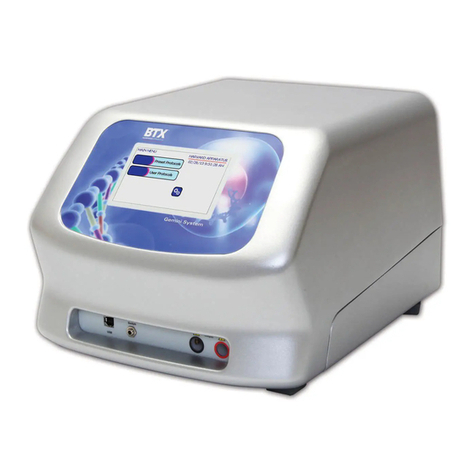
Gemini Series Electroporator User’s Manual
toll free 800.272.2775 • 508.893.8999 • www.btxonline.com
10
Applications
General References (continued)
In Vitro Electroporation (continued)
Zhao, Y. et al., High-Efficiency Transfection of Primary Human and
Mouse T Lymphocytes Using RNA Electroporation. Molecular Therapy,
Vo. 13, No. 1, January 2006
Heaney, J.D. et. al. Tissue-specific expression of a BAC transgene
targeted to the Hprt locus in mouse embryonic stem cells. Genomics,
2004
Raoul, C. et al., Motoneuron Death Triggered by a Specific Pathway
Downstream of Fas: Potentiation by ALS-Linked SOD1 Mutations.
Neuron, Vol. 35, 1067-1083, September 12, 2002
Dawson, K. et al., Insulin-Regulated Trafficking of Dual-Labeled
Glucose Transporter 4 in Primary Rat Adipose Cells, Biochemical and
Biophysical Research Communications. 287, pp. 445–454, 2001
In Vitro Electroporation
Johannson, D. et. al., Intradermal Electroporation of Naked Replicon
RNA Elicits Strong Immune Responses. PLoS ONE, 7(1): e29732, 2012
Daftarian, P. et. al., In vivo Electroporation and Non-protein Based
Screening Assays to Identify Antibodies Against Native Protein
Conformations. Hybridoma, 30(5); 2011
Hallengard, D. et. al., Comparison of plasmid vaccine immunization
schedules using intradermal in vivo electroporation. Clinical Vaccine
Immunology, 2011
Bolhassani, A. et. al., Improvement of different vaccine delivery systems
for cancer therapy. Molecular Cancer, 10(3), 2011
Li, W. et. al., The Effects of Irreversible Electroporation (IRE) on Nerves.
PLoS ONE, 6(4), 2011
Lladser, A. et. al., Intradermal DNA electroporation induces survivin-
specific CTLs, suppresses angiogenesis and confers protection against
mouse melanoma. Cancer Immunol Immunother, 59; 81-92, 2010
Shi, W. et al., Generation of sp3111 transgenic RNAi mice via
permanent integration of small hairpin RNAs in repopulating
spermatogonial cells in vivo. Acta Biochim Biophy Sci, 42(2): p 116,
2010
Haller, BK. et. al., Therapeutic efficacy of a DNA vaccine targeting the
endothelial tip cell antigen delta-like ligand 4 in mammary carcinoma.
Oncogene, 29, 4276-4286, 2010
Guo, Y. et. al., Irreversible Electroporation Therapy in the Liver:
Longitudinal Efficacy Studies in a Rat Model of Hepatocellular
Carcinoma. Cancer Research; 70(4) February 15, 2010
Roos, A. K. ,Skin Electroporation: Effects on Transgene Expression,
DNA Persistence and Local Tissue Environment. PLoS ONE, 4(9) e7226,
2009
Brave, A. et. al., Late administration of plasmid DNA by intradermal
electroporation efficiently boosts DNA-primed T and B cell responses to
carcinoembryonic antigen. Vaccine, 27, 3692-3696, 2009
Roos, A. K. et. al., Optimization of Skin Electroporation in Mice to
Increase Tolerability of DNA Vaccine Delivery to Patients. Molecular
Therapy, 17(9), 1637-1642, Sep 2009
Danner, S. et. al., Seminiferous tubule transfection in vitro to define
post-meiotic gene regulation. Reproductive Biology and Endocrinology,
7(67), 2009
Benton, C. et al., Modest PGC-1_ Overexpression in Muscle in Vivo
Is Sufficient to Increase Insulin Sensitivity and Palmitate Oxidation in
Subsarcolemmal, Not Intermyofibrillar, Mitochondria*. The Journal of
Biological Chemistry, 283(7); pp. 4228–4240, February 15, 2008
Chesler, A. T., Selective Gene Expression by Postnatal Electroporation
during Olfactory Interneuron Neurogenesis. PLoS ONE, 3(1): e1517,
2008
Rao, N. M. et al., Electroporation of Adult Zebrafish. S. Li (ed.),
Electroporation Protocols: Preclinical and Clinical Gene Medicine.
Methods in Molecular Biology, Vol. 423. p 289, 2008
Johnson, C. J. et al., Technical Brief: Subretinal injection and
electroporation into adult mouse eyes. Molecular Vision, 14:2211-
2226, 2008
Heller, L. et. al., Comparison of electrically mediated and liposome-
complexed plasmid DNA delivery to the skin. Genetic Vaccines and
Therapy, 6(16), 2008
Roos, A.K., et. al., Enhancement of Cellular Immune Response to
a Prostate Cancer DNA Vaccine by Intradermal Electroporation.
Molecular Therapy, 13(2), February 2006
Kong, X. C. et al., Inhibition of synapse assembly in mammalian muscle
in vivo by RNA interference. EMBO Rep, 5(2): 183-188, January 2004
Pringle, I. A. et al., Duration of reporter gene expression from
naled pDNA in the mouse lung following direct electroporation and
development or wire electrodes for sheep lung electroporation studies.
Molecular Therapy, 9, S56–S56, 2004
Mikata, K. et al., Inhibition of Growth of Human Prostate Cancer
Xenograft by Transfection of p53 Gene: Gene Transfer by
Electroporation. Molecular Cancer Therapeutics, Vol. 1, 247–252,
February 2002
Pekarik, V. et al., Screening for gene function in chicken embryo using
RNAi and electroporation. Nature Biotechnology, 21: 93-96, December
2002
Dujardin, N. et. al., In vivo assessment of skin electroporation using
square wave pulses. J Controlled Release, 79, 219-227; 2002
Drabick, J.J. et. al., Cutaneous Transfection and Immune Responses to
Intradermal Nucleic Acid Vaccination Are Significantly Enhanced by in
Vivo Electropermeabilization. Molecular Therapy, 3(2), Feb 2001
In Utero Electroporation
Maiorano, N. A., et al., Promotion of embryonic cortico-cerebral
neuronogenesis by miR-124. Neural Development, 4:40, 2009
Ex Vivo Electroporation
Deora, A.A. et. al., Efficient Electroporation of DNA and Protein into
Confluent and Differentiated Epithelial Cells in Culture. Traffic, 8:
1304-1312, 2007
Thomas J-L. et. al., Electroporation, an alternative to biolostics for
transfection of Bombyx mori embryos and larval tissues. Journal of
Insect Science, 3:17, 2003
Dimitrov, D.S., and Sowers, A.E., (1990) Membrane electroporation -
fast molecular exchange by electroosmosis. Biochimica et Biophysica
Acta 1022: 381-392.




























